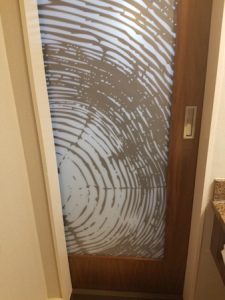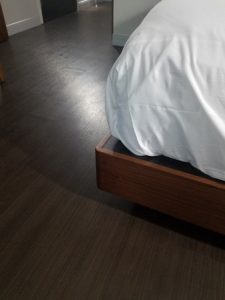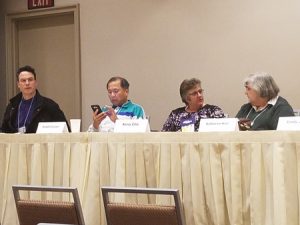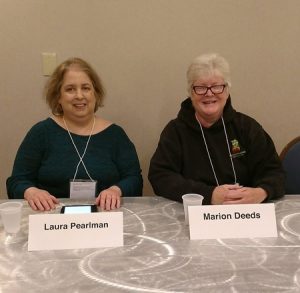March 10th through 12th I attended FOGCon, held in Walnut Creek in the San Francisco east bay. This is my third FOGCon, and it’s one of my favorite conventions.
I also really like the Walnut Creek Marriott where the convention is held. I’ve stayed there three times and each time every single person, from the parking guys to the concierge and front desk people to random housekeepers I’ve seen in the corridors, has been friendly, cheerful and helpful. The housekeepers will smile at you first. They are quick to take care of any problem.
Having said that, I liked this year’s FOGCon, but I wouldn’t say I loved it.
FOGCon’s own programming has always embraced political and social issues. This is one of the things that makes the convention interesting. This year, though, I wasn’t going to FOGCon for political activism; I was looking for respite.
I avoided the following panels, “How Did You Survive the Election?” and “When Do You Pick Up the Blaster?” which looked at the revolution-as-war motif and asked if it was necessary. By the way, I steered clear of it, but the audience for this one was packed and may have reached standing room only, so clearly it’s a popular topic. I also stayed away from “Writer as Resistor” although that panel seemed to take a more historical approach.
The theme was “Interstitial Spaces” so I looked for panels that discussed things that were in-between. One of my favorites was the Interstitial Biology panel, which explored the ways supposedly non-sapient species communicate and react to their environments.
FOGCon always has good panels for writers. I attended the editing panel which was very nuts-and-bolts and inspiring. I went to “Writing Cross-Genre” and “Between the Pixie and the Crone” which took a look at the role of the middle-aged woman as protagonist in SFF.
My first small disappointment was the hotel room. The Walnut Creek Marriott has remodeled its rooms. They have taken up all the carpeting. I see several reasons for this; 1) discouraging bedbugs, 2) reducing allergens and 3) saving on cleaning costs. They chose a dark vinyl composite flooring product that, well, looks like vinyl. Instead of drapes – see all the reasons for eliminating the carpet above – they installed a thick shade that really does cut the light and creates almost blackout conditions. The design points in the room are meant to convey the feeling of wood and trees, including a slightly baffling sliding door that is either the bathroom door or the closet door. Very interstitial!
In theory this would have a calming, plantation-like look to it; to me, it looked like a bunker. The very plain utilitarian work/storage/TV space looked like shelves when I first opened the door, and with the dark fake-wood floor I wondered if my key had somehow opened the door to a storage room by mistake. The bedframes, rich, caramel colored wood, extend out past the curve of the blindingly white mattress, creating an excellent opportunity for a guest to walk into it and hurt herself. Ask me how I know that.
And the new carpet in the corridor looks like the chalk outline for corpses – many corpses, some not quite human. The Walnut Creek Marriot should consider hosting a horror convention. They would love that carpet.
Everything else about the Marriott was excellent as always.
In keeping with the theme, I found that this year, my best moments came in between the panels and formal events, happening in conversations in the registration area, at the readings, or in the bar.
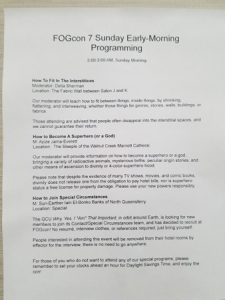
Click to enlarge, because the text is funny. This is the “interstitial” programming between 2:00 am and 3:00 am on Daylight Saving Sunday.
Interstitial biology talked about the way plants communicate with each other by releasing hormones into the air. The acacia tree releases a substance that turns its leaves bitter when the leaves are “attacked” (giraffes are eating them). They also release a hormone that floats on the wind to the acacia trees downwind, and their leaves turn bitter too.
The panel discussed colonial organisms like coral and cloned organisms like the groves of aspen trees that are all grown from runners of one original tree. Forests share information via bacteria on their roots, and via certain fungi. My favorite tidbit was that cephalopods (octopus) have neuron bundles on their tentacles. Those bundles allow them to react more quickly to environmental changes, because information does not have to travel all the way to the main brain and back. In other words, a distributed brain, kind of.
*
In the bar, I told a group I’d always had a moment in the Firefly wrap-it-up movie Serenity where I wondered what would happen if River, instead of killing the final Reaver, joined him and went off to be the Reaver Queen. We all immediately started creating the story of River as the Reaver Queen.
*
The first reading I went to included YA writer Garrett Calceterra, Nancy Jane Moore, Madeleine Robins and Laura Blackwell. I went to hear Laura. She read first (they went alphabetically by last name), from her dark, disturbing and lovely horror story “Bitter Perfume.” You can find it in the Lovecraftian horror anthology She Walks in Shadows.
Garrett is working on a pulp-action adventure for adults, that has military folks, dinosaurs, steampunkish magic and a woman MC. It was lively, sweary and funny. He has only written three chapters so far, he said, but if it were out now I’d buy it.
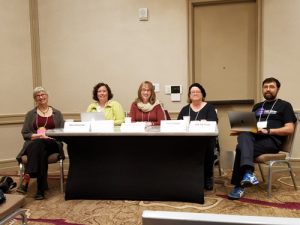
(L to R) Delia Sherman, Laurel Amberdine (Lightspeed); Laura Blackwell, freelance, Sarah Stegall, freelance, Jed Hartman, Strange Horizons
From the Editing Panel, Laura Amberdine, who is an editor at Locus and an editorial assistant for Lightspeed; “A good editor finds out what the writer is trying to do and helps them do it.”
Overheard in the registration area: “Whatever you do, don’t call it Urban Fantasy. That’s dead.”
My second disappointment had to do with strange issues with the program. The convention’s big program was beautiful and comprehensive. The registration packet included a two-page summary of the program, and a one-page at-a-glance summary. And the programming was on the website. On each of those documents, the information about readings was different. This alone isn’t uncommon; guests often accidentally get double-booked or ask for last minute changes. I was interested in my reading though, and what showed on the website was that I would be reading with Laura Pearlman. Originally I had been told there were four of us and I had that old e-mail, but it looked like two of those people were reading at different times. Laura and I exchanges e-mails and we felt prepared.
On the one-page at-a-glance grid, four completely different names showed in that time slot, but the big program still showed me and three others. The three-pager showed Laura and me.
As it turned out, it was Laura Pearlman and me. Laura writes comedy horror in super-short stories, and it was hard for me to read afterward because I was breathless from laughing.


